Contents
Anyone who raised pigs knows very well that these animals are prone to many dangerous diseases. For a novice farmer, this feature of piglets can be an unpleasant surprise: a frivolous attitude to the vaccination calendar often causes a mass death. How and what vaccinations should be given to piglets from birth at home will be described in detail in this article. Here you can also find a vaccination calendar, recommendations for injections, a list of microelements and vitamins necessary for pigs.
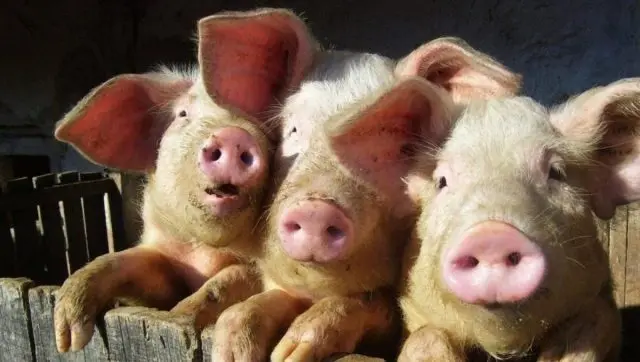
Benefits of timely vaccination
It’s no secret that pigs raised on an industrial scale are subject to mandatory vaccination. And the point here is not only the sanitary and epidemiological requirements for meat – vaccinations protect piglets from the most common and deadly diseases.
As in the case of humans, the main purpose of mandatory vaccination of pigs is to prevent an epidemic (mass spread of infection). It is necessary to vaccinate domestic livestock in order to protect yourself from a one-time loss of the entire herd.
Protecting the body of piglets begins from birth, when babies still have very weak immunity. A farmer can save a pig herd not only from deadly diseases, but with the help of vaccinations and injections, it is possible to really prevent the development of beriberi, a deficiency of important microelements, and strengthen the immune system of each piglet.
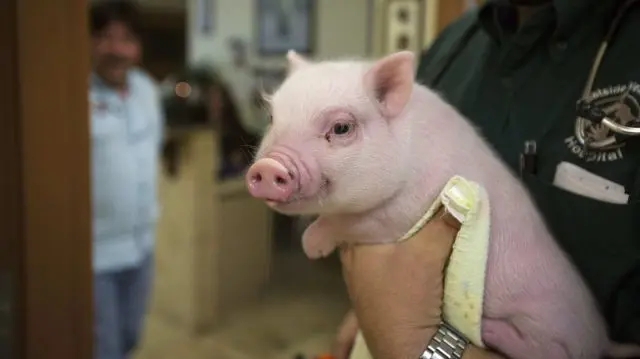
Do not be afraid of vaccinations: modern preparations for vaccinating pets have practically no side effects – after the injection, the piglets will feel the same as before.
What vaccinations are given to piglets from birth
Immediately after birth, no injections can be given to piglets, because the body of newborns is still too weak. It is recommended to start the first vaccination not earlier than the third or fourth day after the pigs are born. Along with vaccinations, piglets should also receive vitamin injections, which many farmers mistakenly refer to as vaccinations.
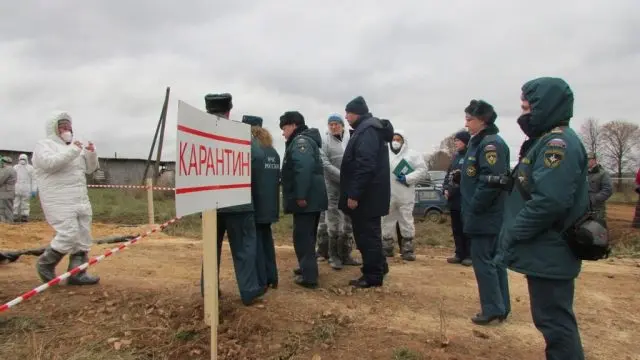
The exact vaccination schedule for each specific livestock should be drawn up by a veterinarian, because the number of vaccinations depends on many external factors, such as:
- the presence of epidemics in the region or region;
- the geographical location of the economy;
- the number of pigs in the herd;
- breed and species of animals;
- free grazing or indoor keeping of pigs;
- type of food;
- possible contact of piglets with other domestic animals.
In small households, vaccination of piglets from birth is carried out according to the following approximate schedule:
- At the age of 4-5 days, piglets are given iron preparations to prevent anemia in animals.
- At two months old, pigs need to be vaccinated against erysipelas.
- At the age of three months, piglets are vaccinated against classical distemper.

Usually, these precautions are sufficient to protect livestock from mortality and disease. If the owner has a small farm, and he raises pigs for the purpose of selling meat or breeding small piglets, the vaccination scheme is somewhat expanded. Large livestock should be vaccinated as follows:
- Piglets 4-5 days – iron preparations.
- From two weeks to a month – a combined vaccination against salmonellosis, pasteurellosis, enterococcosis.
- At one and a half months – vaccination against the COP (classical plague).
- At 2 or 2,5 months, piglets need to be vaccinated against erysipelas.
- At the age of 3 to 3,5 months, pigs are revaccinated against erysipelas.
- In the interval from 3,5 to 4 months, the vaccination against salmonellosis, pasteurellosis, enterococcosis is repeated.
- Up to six months, piglets are re-introduced with the erysipelas vaccine.
Вакцины
For pigs of all breeds, the same vaccines are used. To protect against each disease, there are several drugs, among them there are both combined and mono vaccinations. When choosing one or another vaccine, you should pay attention only to the age of the piglet and its approximate weight.
Piglets can be vaccinated against classical distemper with one of the following vaccines:
- “VGNKI virus vaccine”;
- “CS”;
- “Virus vaccine LK-VNIIVViM”;
- “ABS”.
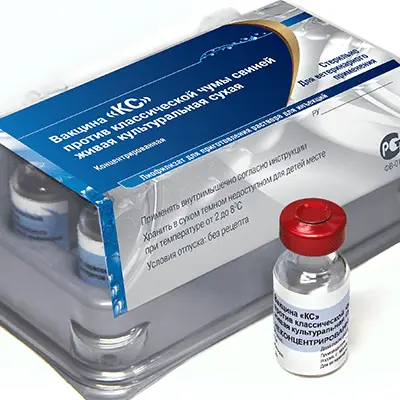
Against erysipelas in piglets, veterinarians recommend using the following drugs:
- liquid deposited “Vaccine against swine erysipelas”;
- “Vaccination against swine erysipelas from strain BP-2”.
In cases of a difficult epidemiological situation, it is better to use combined preparations for vaccinating piglets and pigs that can protect the herd from several diseases at once. Typically, such drugs prevent three of the most dangerous diseases in pigs: pasteurellosis, enterococcosis, salmonellosis. Among the most popular are the following vaccines:
- “Verres-SPS” can be administered for the first time to 10-12-day-old piglets. On the 8-10th day after this, revaccination is carried out.
- The vaccine “Suigard” according to the instructions for use can be injected to piglets 20-30 days old, or sows 15-40 days before the expected farrowing.
- The drug “PPS” is available in vials of 20 doses and it is intended for 12-15-day-old piglets or sows before childbirth.
- “Serdosan” is able to develop in pigs immunity to five diseases at once. In addition to the three listed, these are colibacillosis and edematous disease.
- For piglets, you can use the PPD vaccine, which must be administered for the first time at 20-30 days of age.
Additional drugs
For little piglets, not only diseases and infections are terrible, the usual deficiency of trace elements or vitamins can cause serious health problems for them.
The most dangerous condition in newborn piglets is anemia. In order to prevent iron deficiency, in the first days of life, pigs are given prophylaxis with special preparations. On the 4-5th day after birth, piglets need to be given an injection with one of the following medicines:
- “Ursoferran”;
- “Suiferrovit”;
- “Ferranimal”;
- “Sedimin”;
- “Ferroglyukin”.
Any iron-containing preparation should be administered at a dosage of 200 mg of active ingredient per piglet.
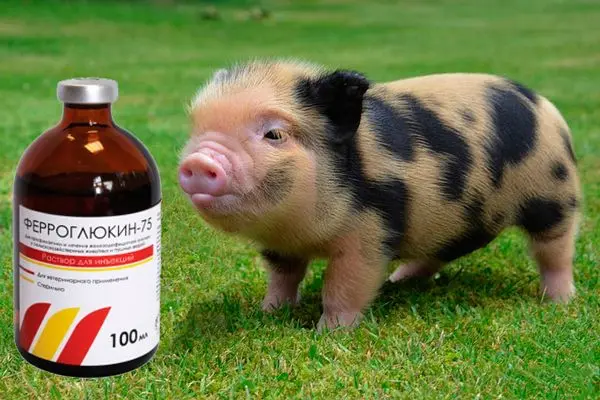
Occasionally, piglets older than ten days may require rickets prophylaxis. In this case, you need to be vaccinated with any preparations of potassium and calcium. As an additional prevention, quartz lamps can be used.
Vaccination of piglets against worms is no less important than vaccinations against deadly diseases. By themselves, helminths do not pose a serious danger to pigs. However, worms greatly weaken the immunity of animals, can clog various parts of the digestive tract. The first time the antihelminthic vaccine is administered to piglets after the tenth day of life. The best drugs are Panakur and Dektomax.
Piglets vaccination rules
The first thing a farmer should know at the initial stage of breeding pigs is what breed his livestock belongs to. Every year, more and more new species of these domestic animals appear, the goal of breeders is to breed breeds that are resistant to the most dangerous and frequent “swine” diseases. That is why many of the modern species of piglets have innate immunity to certain diseases and, accordingly, do not need to be vaccinated against them.
The calendar that veterinarians follow when vaccinating pigs from large industrial farms is called “extended”. At home, not all vaccinations are given to piglets – only those vaccines are chosen that will protect the livestock from diseases common in a particular region and in a certain period of time. A novice farmer with no knowledge of swine diseases can consult with a local veterinarian or talk to more experienced neighbors.
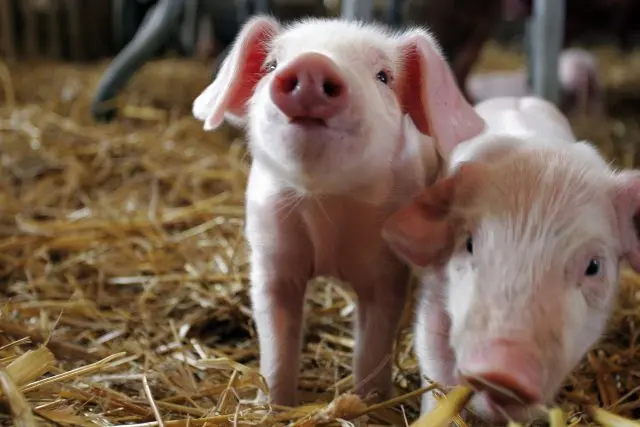
At the time of vaccination, the piglet must be absolutely healthy. Any vaccine is a small stress for the body, so the animal’s immunity cannot be suppressed by poor nutrition, weakness or chronic illness.
So, before vaccinating piglets, you must do the following:
- Learn about the characteristics of a particular breed of pigs and find out to which diseases they have innate immunity.
- Consult with your veterinarian and draw up your own vaccination schedule based on this.
- Observe the piglets and sow for weak, hungry or sick individuals.
- Purchase quality vaccines from a good veterinary pharmacy.
Table of vaccination of piglets from birth
Vaccinations will be of no use if they are not repeated at a certain interval. In order not to miss or forget anything, the farmer needs to draw up a vaccination schedule for his piglets. Veterinarians recommend following the vaccination schedule from the first days of life of pigs. One example of such a table is shown below.
Piglet age | Disease | drug or vaccine | dosage | Note |
3 day | Anemia prevention | Any iron preparation | According to instructions |
|
7-th day | Mycoplasmosis (enzootic pneumonia) | «Respisure» | 2 ml per head |
|
21-28 day | Mycoplasmosis (revaccination) | «Respisure» | 2 ml per head |
|
8 weeks | Deworming | “Panakur”, 22,2% | 2,2 g per 100 kg of weight | One of the suggested drugs |
“Dectomax” | 1 ml per 33 kg of weight | |||
12 weeks | Classic swine fever | Vaccine from the state budget | According to instructions |
|
13 weeks | Deworming | “Panakur”, 22,2% | 2,2 g per 100 kg of weight | One of the suggested drugs |
“Dectomax” | 1 ml per 33 kg of weight | |||
16-17 week | Pig erysipelas | «Porcilis Ery» | 2 ml per head |
|
It must be understood that the above scheme is the simplest option that is suitable for vaccinating piglets in a small household. The larger the population, the more vaccinations need to be done.
Against the plague
The most dangerous disease in pigs today is classical plague. The infection affects 95-100% of unvaccinated livestock and is fatal in 60-100%. Not only the high mortality among infected animals is terrible, but also the sanitary standards in relation to the classical plague: all pigs in the affected area, at best, are forcibly vaccinated, at worst, they are slaughtered and the corpses are burned. And this is a big problem for the farmer!
Only domestic pigs and wild boars are sick with plague – you don’t have to worry about the rest of the livestock in the household. But the infection spreads very quickly, so it is best to be prepared and vaccinate all pigs and piglets in the herd.
Cattle should be vaccinated against plague intramuscularly strictly according to the scheme:
- the first vaccination – for piglets at the age of 1,5-2 months;
- re-vaccination (after which immunity appears) – on the 120th day after the first;
- revaccination – every year.
The plague vaccine cannot be bought at a pharmacy; it is issued only at the sanitary and epidemiological service.
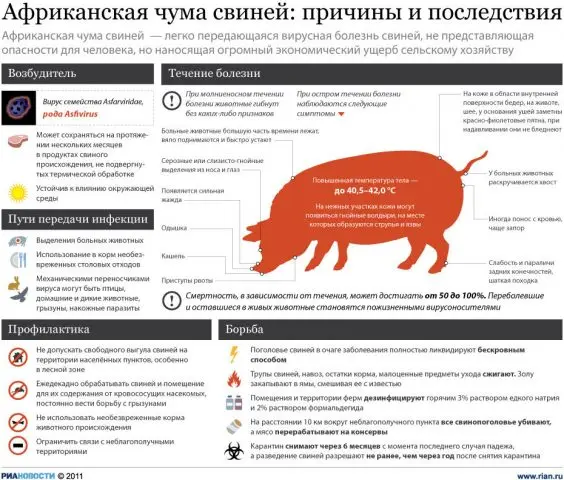
Against salmonellosis
Salmonellosis is transmitted by airborne droplets, therefore it is considered a rapidly spreading infection. The disease itself is not fatal, but it proceeds severely, consequences are often observed in pigs – animals lag behind in growth, lose their appetite, and their immunity decreases.
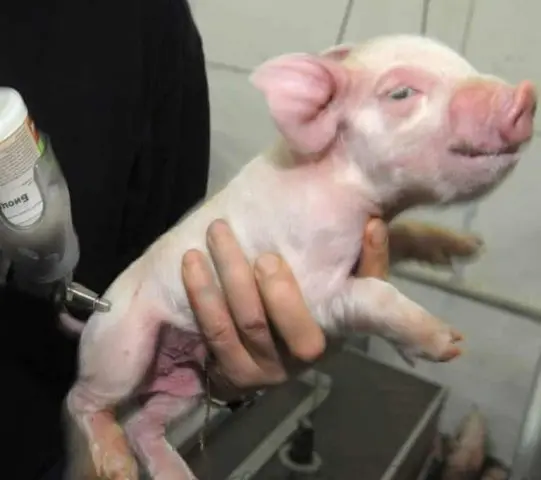
Vaccination against salmonellosis is carried out in two stages:
- Vaccination is given to 20-day-old piglets.
- After 7-10 days, revaccination is carried out.
Usually, farmers use complex vaccines to prevent salmonellosis, which also protect against pasteurellosis and enterococcosis. The best is the drug “Suigard”, which can be purchased at a veterinary pharmacy.
Against the faces
Erysipelas is a skin bacterial infection. This disease causes severe discomfort to pigs, infected animals suffer greatly. The causative agent of erysipelas can live for a long time in the body of a healthy pig, and with a lack of nutrition or deterioration in living conditions, the infection suddenly flares up, affecting the entire herd.
The disease is not always fatal, but the treatment of piglets from erysipelas will require considerable financial costs. Therefore, vaccination is the best option, it is carried out both in industrial and small households.
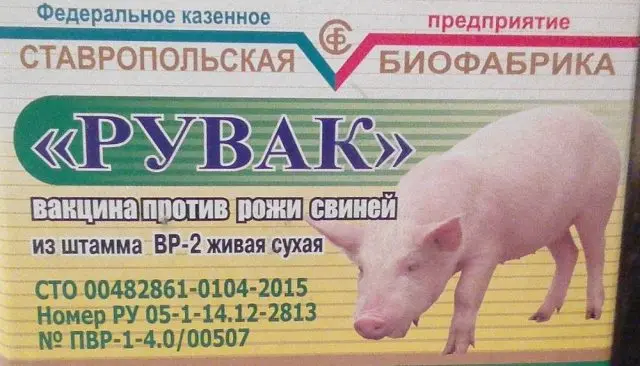
The vaccination scheme for piglets against erysipelas is as follows:
- the first injection – at two months of age;
- repeated injection – on the 85-90th day after the first;
- revaccination – after 240 days.
You can choose any vaccine for pigs, “BP-2” is praised from domestic ones.
Against Aujeszky’s disease
The Aujeszky virus infects not only pigs, but also other domestic animals (rodents, dogs, cats). The first to suffer from infection are small piglets, the disease spreads very quickly throughout the entire population of young animals. Mortality from Aujeska among piglets under the age of four weeks reaches 100%. Adult pigs usually recover, but the course of the disease is also severe.
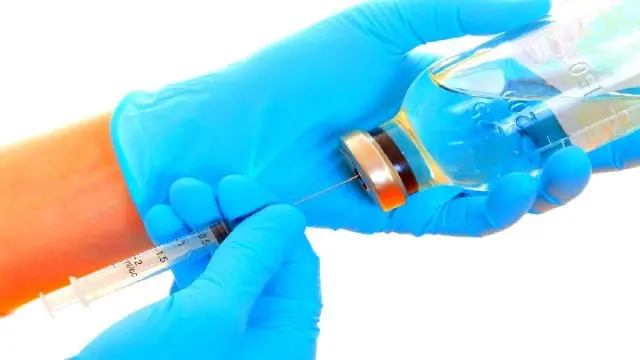
Vaccinations from Aujeska to piglets do this:
- on the 16-30th day after birth, piglets are injected with 1 ml of the drug subcutaneously;
- the second vaccination should be done intramuscularly – 2 ml for 35-55 days;
- revaccination – also intramuscularly 2 ml on the 140th day.
The drug “VGNKI virus vaccine dry cultural against Aujeszky’s disease” is effective.
Advantages and disadvantages of complex vaccination
Combination vaccines consist of inactivated (not live) strains and viruses. They do not harm the body of small piglets, do not give adverse reactions. However, combined vaccinations have their own nuances:
- immunity in animals is developed only two weeks after re-vaccination (revaccination);
- repeated vaccination of pigs with combined preparations is necessary every five to six months.

That is, during the epidemic, it is not advisable to use combined vaccines – until the piglets have an immune response, most of the herd will fall ill. In a “calm” time, it is possible and necessary to vaccinate pigs with such vaccinations.
Table of other vaccinations for piglets
When a farmer plans to raise or raise pigs for meat, the herd should have a more complete “vaccination record”. Additionally, it is recommended to vaccinate piglets according to the scheme below.
Disease | First vaccination | Revaccination | Preparation |
Leptospirosis | 1,5 months | After 7 days | “Polyvalent vaccine VGNKI” |
Encephalitis (Teschen’s disease) | 2 month | Need not | “Suimun Teshen” |
Foot and mouth disease | 2,5 month | Need not | “Immunolaktan” |
Potassium + calcium | 10 days | Need not | “Tetravit” |
Hardware | 3-5 day | Course – three days | “Ferranimal” |
Preparing piglets for vaccination
Piglets to be vaccinated do not need special preparation. But this is provided that the farmer follows the recommendations of veterinarians and adheres to the vaccination schedule. For example, pigs that have not previously been vaccinated against helminths must undergo antihelminthic treatment. To do this, you can choose any drug in tablets or drops.
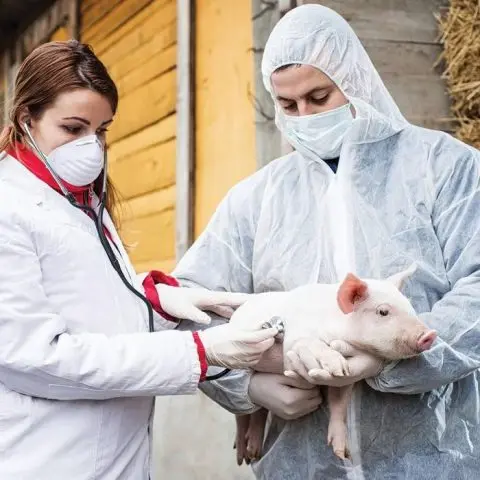
The owner must definitely inspect each individual from the herd in order to identify weak and suspicious piglets – these should not be vaccinated. It is good if serious vaccines (combined drugs, vaccinations against leptospirosis or pneumonia) are administered to domestic pigs by a doctor. But the farmer can do iron, minerals and vitamins, injections against helminths on his own.
How to inject a piglet
In order to correctly deliver an injection with a vaccine, the piglet, first of all, must be well fixed. To do this, you will need an assistant: one person should hold the mumps, and the second should inject.
Even before catching a piglet, it is necessary to dissolve the vaccine according to the instructions, calculate the dose and draw up the medicine. Syringes and needles for them are also not taken at random: their sizes depend on the age of the pig and the type of vaccination. This is detailed in the table below.
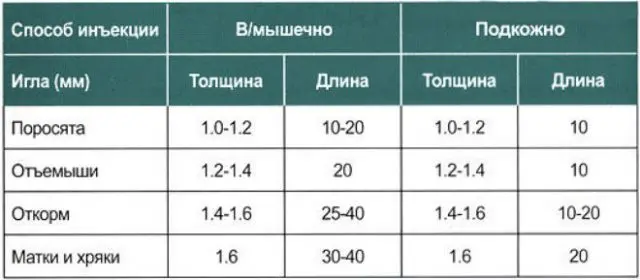
Vaccinations for pigs must be delivered correctly:
- it is necessary to observe sterility;
- put on gloves before vaccination;
- use a separate needle for each piglet;
- pre-wipe the injection site with 70% alcohol.
Where to prick a piglet
The injection site and type of injection depend on the vaccination product and the age of the pig. Therefore, before you vaccinate a piglet, be sure to read the instructions for the medicine. The options may be:
- Small suckling pigs are vaccinated in a triangle behind the ear, the drug is administered subcutaneously. It is necessary to pull the skin with your fingers and insert the needle at an angle of 45 degrees into the resulting fold. This is the most painless injection method.
- Subcutaneous injection can also be performed on the inner surface of the thigh. They do everything in the same way as with the ear.
- Older piglets are vaccinated in the thigh. The injection should be done intramuscularly, trying not to touch the large vessels. The needle should be inserted at a right angle.
- In weaned piglets and adults, intramuscular injections can be given in the neck. In babies, a distance equal to the thickness of two fingers recedes from the auricle. To determine the injection site in an adult pig, a palm is applied to the ear.

Monitoring piglets after vaccination
After vaccination, the piglet needs observation and good care. In order for the immunity of babies not to weaken, and the body to cope with the vaccine normally, animals need to create optimal conditions, such as:
- the temperature in the barn is at the level of 20-25 degrees;
- average air humidity;
- cleanliness and regular cleaning;
- quality food and constant access to water.
That is why it is better not to vaccinate piglets in severe frosts or strong heat.
Conclusion
Vaccinations for piglets from birth at home can and should be done even in private farms with a small livestock. In order not to harm animals, it is necessary to follow the recommendations of veterinarians and carefully read the instructions for the drugs. It is quite possible to inject vitamins, iron or calcium preparations to pigs, to make antihelminthic or combined vaccinations on your own, but for more serious immunization it is better to call a specialist.









